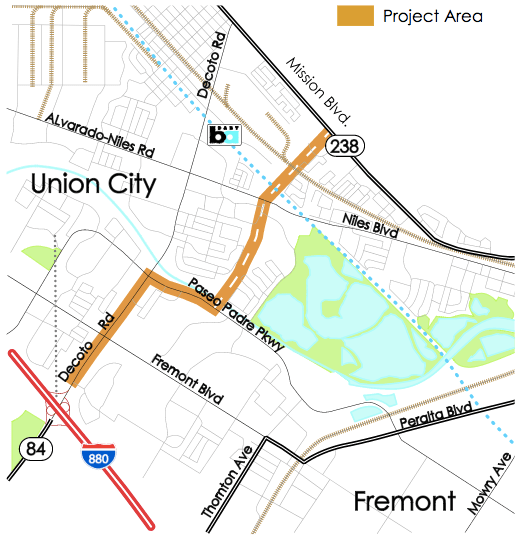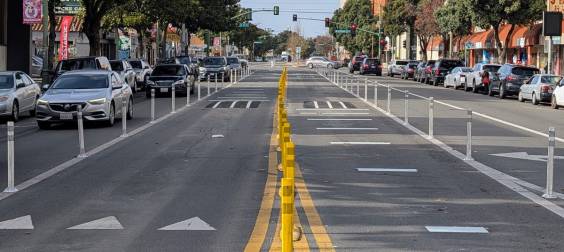The residents who showed up to comment in Union City's proposal to pay for a new, fast highway connection were not in favor of the plan. But despite their objections, the city council of this small Bay Area city decided that money set aside to build out its bike plan, improve travel speeds for transit, and build a new intermodal transit transfer hub should be spent instead on encouraging more driving.
The councilmembers argued that a new four-lane road connecting two busy highways, which would require several grade separations and three new bridges, is absolutely needed. Councilmember Pat Gacoscos pointed to the city’s (slightly) expanding population as one rationale. Councilmember Lorin Ellis said the road was an essential first-mile connection to the BART station, which it would pass near. The road is necessary to serve an office development proposed near the BART station, said councilmembers, because Union City needs the development to shore up its shaky financial situation. Mayor Carol Dutra-Vernaci went so far as to claim that “nobody will build at the BART station without this roadway.”
The new connector road “would allow buses,” said staff, who also promised that some form of buffered bike lanes would be incorporated along it. But the diverted money, which is not enough to pay for the entire very expensive road in any case, doesn't include funding for more buses, nor would it do anything else to improve transit access or speed transit travel times. The road is also not prioritized in the city's bike plan as a necessary bike connection.
The $100-million-per-mile road would suck up all the local money from the voter-approved county sales tax Measure BB that is currently set to be used for transit and bike and pedestrian projects.
Union City staff suggested that some of the Measure BB money could be replaced by funds the city expects to receive from the statewide gas tax. Also, an upcoming ballot measure, Regional Measure 3 (RM3), seeks to raise tolls on regional bridges to pay for transportation improvements, and Union City sees that as another source of replacement funds.
Measure BB passed—just barely—after an earlier failed attempt. One of the reasons it passed on the second try was because it included a detailed expenditure plan that promised transit and bike improvements. That plan had the support of a wide range of groups including the local bike coalition, sustainable transportation advocates, and labor, all of whom participated in a get-out-the-vote drive that pushed the measure past the required 2/3 vote mark.
If Union City can so easily take money from transit and bike improvements and spent it on a new highway, why would voters be willing to approve any new taxes or tolls or fees?
And if Union City can unilaterally shift money from one pot to another, what's to prevent other municipalities from seeing their shares of state gas tax revenues as potential backfill funding for any old project? If Union City can do this, then all the work that went into creating sensible, fix-it-first guidelines for spending gas tax revenue is out the window.
Supporters of RM3, and anyone involved in the fight against the threatened repeal of S.B.1, would be right to worry about Union City's actions.
Even if this small city's betrayal of voters' trust were not important to the region, the city's geographic situation is. Regional transit plans are being formulated for future railroad connections in Union City between Amtrak's Capitol Corridor trains serving Sacramento and San Jose with ACE trains going east to Livermore as well as BART. Future connections across the Dumbarton bridge to the San Francisco peninsula, either by rail or rapid bus, would also be served by that hub, potentially placing Union City at the center of a major regional transit service hub.
Studies of the Dumbarton corridor suggest ways to speed up transit and encourage carpooling both to and on the bridge. Those strategies, like bus-only lanes and transit signal priority, would have a much more beneficial effect on travel times, not to mention travel options and emissions reductions, than building a new road that would dump more cars onto the bridge and surrounding highways. According to Adina Levin of Green Caltrain,
Union City didn’t mention the East West Connector at all in their comment letter to SamTrans on the Dumbarton Corridor Plan. The mayor and staff are describing this project as their most important contribution to Dumbarton Corridor mobility. If that’s the case, why did they not highlight this a few months ago when commenting on the Dumbarton Corridor Plan?
Levin also has suggestions for better alternatives than pouring all that money into encouraging more car traffic, such as taking a closer look at that Dumbarton Corridor Plan and supporting some of the strategies in it.
Union City's plan will next be taken up by the Alameda County Transportation Commission at their March meeting. The commission has its own reasons to approve this plan, which includes Union City agreeing to take on all fiscal responsibility for the project, allowing ACTC to wash their hands of it. It will be interesting to see what questions the commissioners ask.






